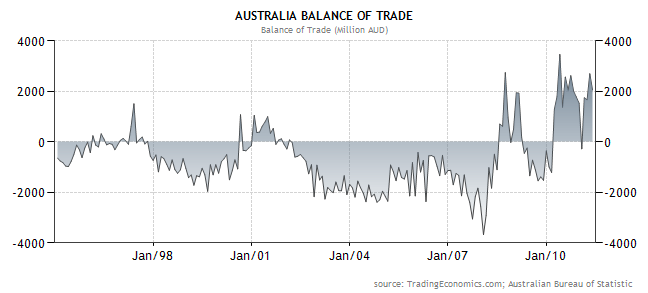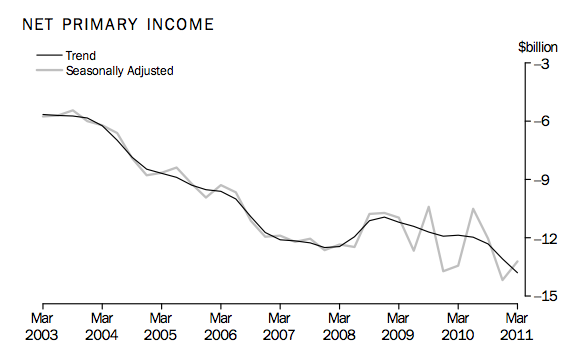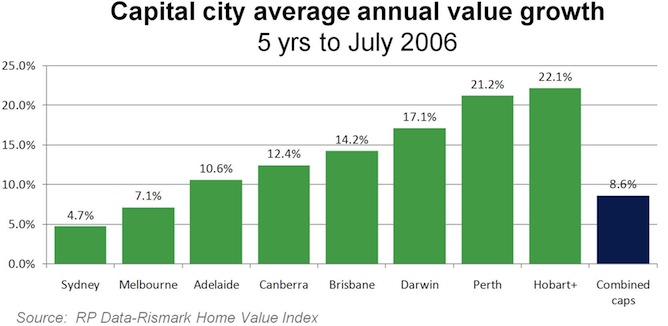Tell me the first country that comes to mind when I state the following economics terms.
Long running current account deficits, large private sector debt, high household indebtedness, high hidden inflation, falling productivity, falling real incomes, hot money flows, asset bubbles.
Greece ? Spain ? Italy ? How about Australia?
Last week I posted an overview of the Australian economy and why, in my view, the economy is fundamentally flawed. Let me re-cap the major points.
Government policy and de-regulated banking and have created an imbalance in which Australian households have become highly indebted to housing while investment in business has weakened. This has led to falling production and growing external debt as the country has had to depend on increasing foreign capital to support business investment and credit issuance. This has meant that Australia continues to sell-off national wealth in order to maintain its standard of living while the household sector becomes increasingly indebted.
In my opinion this is THE major issue facing the Australian economy today and everything else is a side show. I assume that many economists, including those that work for the government and the RBA, believe that the mining boom is able to reverse these trends, and I agree that it could, but not under the current circumstances.
So over a series of posts I want to clarify my position on this topic and also provide a forum to discuss some possible solutions. I by no means claim to have all the answers and as usual am looking for feedback from the intelligent audience that is the MacroBusiness community.
Today I am going to focus on the case for implementing some form of capital controls which, as I mentioned earlier in the year, are slowly coming back into favour.
Australia has a long running current account deficit. In simple terms this means that we continually borrow goods,services and capital from other countries in order to run our economy. Many economists don’t see current account deficits as an issue, in the same way that they don’t recognise private sector debt as one, because in many cases they are not. But a long running current account deficit highlights that there is an economic imbalance in the non-export sector of an economy that if left unchecked will usually, eventually, lead to an economic crisis. In Australia the long running CAD has manifested as household indebtedness and more recently failing production and falling incomes.
The current account is made up of two major components, the trade balance and the capital account. The trade balance is simply the difference the amount the country exports and the amount it imports.

You can see that Australia has until quite recently, or during a recession, had quite a bit of trouble balancing its trade. Under a floating exchange system this would normally, all things being equal, cause the Australian dollar to fall against other large trading currencies.
But as we all know that is not what has occurred.
The other part of the current account is the capital account. The capital account records how much capital Australia borrows and lends to the rest of the world. Net primary income is a major component of the capital account:

The capital account is made up of direct foreign investment, portfolio and other investments and transfer, such as foreign aid. You are able to find a breakdown of much of this data here.
What you can see from the chart above is that Australia is a large net borrower from the rest of the world. A large deficit in a capital account along with a deficit in the balance of trade while the currency is rising are all strong evidence that Australia has a problem with currency speculation.
Currency speculation, sometimes called “hot money” , needs to be controlled because it can cause some serious imbalances in the local economy both on the way in, and on the way out. There are a number of well-known symptoms for hot money in-flows, these include:
• Asset bubbles
• Currency appreciation
• Inflation
I think the first two speak for themselves in Australia. In terms of inflation the official figures are relatively low, however I am not so sure the official inflation rate is a true measure of the actual prices stability experienced by Australian households. Last week RPData published some charts of the average house price increases over the last decade. The chart below is for the first 5 years of the last decade.

When the cost of the largest single item purchased by the household sector has been increasing at those rates it seems quite obvious that Australia has had a problem with inflation over the period even if you won’t find it in the official figures. As an aside, I find it quite ironic that the same banking economists who championed the growth of house prices over the last decade are now claiming that an inflation problem is just around the corner as those prices fall. It would seem to me that they have been looking in all the wrong place to make their assessments.
In terms of productivity, something I discussed in my previous post, it seems obvious to me that the falling rate of productivity stems in a large part from the increases in house prices over the last decade. It is very difficult for the business sector to moderate wage demands when the cost of housing is growing so rapidly. It it therefore very difficult to control one of the greatest cost to business, human capital.
I do not think that it is anyway coincidental that Australia’s productivity has decline at the same time as house prices have risen so dramatically. As I have asked previously, why do you think you pay $4.50 for a single cup of coffee? My answer is because the person serving you probably has a $300,000 mortgage.
That mortgage was able to rise to such a level in part because of the demand by foreigners to hold Australian dollar assets. This includes all sorts of financial assets, but importantly it includes bonds and shares issued by our banks and deposits in our banking system. The equity, bonds and deposits all support banking liquidity and therefore credit issuance, even if it is Ex Post Facto.
Deep T has previously reported that it is difficult to determine the level of foreign deposits in the local banking system due to lack of detailed reporting from the RBA, this is something I hope the MacroBusiness team can revisit at a later date.
On top of supporting large rises in housing indebtedness, and therefore wage demands, the carry trade has also added to the pressure on the export sector as they have become increasingly uncompetitive due to the rising exchange rate. With these two pressures it isn’t hard to see why our local manufacturing industries are struggling, but it is also important to note that the banking sector plays a much larger part in this problem than many realise.
So what can be done?
Well we need to find a solution that does the following:
- Slows the currency speculation to bring down the value of the dollar
- Has a limited effect on productive business investment
- Doesn’t set-off a new round of credit driven asset speculation
Taiwan will bar foreign investors from putting money in time deposits with immediate effect, the island’s financial regulator said on Tuesday, as the authority moves to curb what it sees as currency speculation.The Financial Supervisory Commission announced the move at a news conference after the island’s central bank said in October that foreign investors have parked about T$500 billion ($15.5 billion) in Taiwan dollar accounts.
Foreign funds have been actively entering Taiwan’s forex market in recent months, on expectations that the currency will strengthen further.